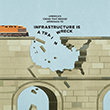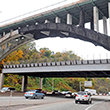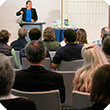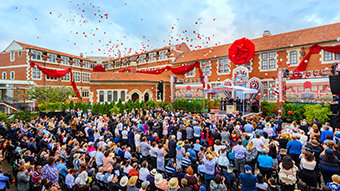Technically, a community is a place—to work, live and congregate. But really, community is about people—fostering a collective spirit, sharing goals, working to make places great and make them their own.
As California’s state capital, Sacramento is usually noted as being the seat of state government. But for the 500,000 people who live there, and 2 million more residing in the city’s suburbs, Sacramento is home. For them, it’s community that counts and the Church of Scientology is part of it.
First established in Sacramento as two large missions, and then as a church in 1973, more than 12,000 people in the area participate in Scientology religious services and studies.






A large, growing congregation means Sacramento is an ideal place for a Scientology Ideal Org—one of a worldwide network of churches providing the optimal environment for Scientology services and study, and where people of all faiths, races, backgrounds and ethnicities can come together and work toward positive social change.
What does Scientology’s Ideal environment look like? Parishioner Chuck Shinneman, a mechanical engineer who advised on the Sacramento project, explains that Ideal Orgs require special care from the very beginning. “If an Ideal Org is going to be built out from an existing structure, the first consideration is that it has enough physical space to allow for very specific interior space planning, because the size, location and features of the course rooms, the spiritual counseling facilities and the communal spaces are necessary for the standard practice of the religion and to run our different community programs,” Shinneman explains. “The size of the room, where the rooms are located, all of that is part of what makes an Ideal Org.”
Bob Johnson, another Sacramento Scientologist, explains how the local congregation knew they had outgrown their old church. “The previous Sacramento Org, which was like many orgs before they became Ideal—well, it definitely was not an ideal space,” he says. “It was more of a make-do situation. It got to the point where we no longer had the room to accommodate our expansion and do all the different activities we wanted to engage in.”
“It became obvious,” Johnson continues, “that we needed someplace 55-60,000 square feet—minimum—to accommodate all the things you need in an Ideal Org—the reception area, the public information center with all the video displays, the bookstore, the little café, a decent size chapel, all the course rooms and everything else.”
Toward making sure every Scientology congregation has premises ideally suited for the many and varied religious services of Scientology, and for carrying out the Church’s social betterment works, Scientology ecclesiastical leader David Miscavige launched an ongoing program in 2004 to acquire new buildings for the religion’s growing membership worldwide. And he has a very specific strategy.
“The whole concept of an Ideal Org—the intent of L. Ron Hubbard, our religion’s founder—is belonging to a community and giving to a community,” he says.




When selecting locations, the Church looks not only for the features needed to create the Ideal environment, but buildings that have some local historical significance or serve a civic purpose. In the case of Sacramento, they got both: a building resurrected from the original fabric of Sacramento, and—with the Ideal Org renovations—one that contributes to the revitalization of the city’s downtown.
Sacramento, like many cities in America, has had its ups and downs. First chartered in 1850 as a boomtown during the California Gold Rush, it became the state capital four years later. It went on to become a terminus for railroads, the Pony Express and telegraph service—all of which ensured the city’s importance, if not prosperity. Sacramento’s economy has suffered along with the rest of the country since the economic crash of 2008, and the federal government’s shuttering of nearby military bases worsened the blow. But the city is now seeing a resurgence of downtown development with a new arena project for the NBA’s Sacramento Kings—and with the Church of Scientology Ideal Org, which was developed in a nearby historical building.
The “Ramona” is one of Sacramento’s most prominent architectural landmarks, and is intrinsically linked to its history—standing on the original route settlers and prospectors trekked to get to the gold mines. Originally opened in 1930 as the Ramona Hotel—one of the city’s ritziest inns—and designed by California’s first state architect, George Sellon, the building is Sacramento’s finest surviving example of the Spanish Colonial Revival style.
In its transformation to an Ideal Org, the Church meticulously preserved the building and restored its features to their original glory, including the characteristic stucco, ornamental glazed brick and terra cotta tiles, decorative iron accents and the original blade sign. All restoration was planned and executed for minimal environmental impact and maximum sustainability, meeting the U.S. Green Building Council’s Leadership in Energy and Environmental Design (LEED) silver certification standards.
Shinneman says sustainability points were earned for using the original structure (rather than tearing it down and building a new one), recycling over 70 percent of existing material through construction waste management, installing energy efficient lighting, and using building materials low in VOCs (Volatile Organic Compounds). The Sacramento Org’s green program extends to the building’s operation and maintenance, according to Shinneman. This includes using environmentally friendly cleaning materials and an air-filtering system.
“That actually happens to be an area that L. Ron Hubbard had written policy on many years ago and is something that the Church does on all its facilities and has done for years.”
Parishioner Bob Graves, who participated in the fundraising efforts for the building work, says he and other local parishioners were motivated by the fact that, with the Sacramento Ideal Org project, they could set an example for future downtown development that was aligned with both the community’s values and its civic goals. “The fact that we came in and set the standard for the renovation of this historical building and made it environmentally appropriate really was inspiring,” he says. “It demonstrated our understanding and appreciation for what the city is trying to do.”
Sacramento Mayor Kevin Johnson acknowledged the effort at the 2012 opening ceremony for the downtown Ideal Org. “We’ve been trying to revitalize our downtown area, and the Church of Scientology came to us and said, ‘Look, we want to help. We want to take a historic building and preserve it and renovate it and make it a masterpiece for the downtown area showcase’—you guys have done your part.”
“And I’m thinking about your community of 12,000 members in the Sacramento area,” Johnson continued. “And you guys raised $15 million to make this renovation happen. Give yourselves a round of applause!”
That applause had barely died down when big things started happening downtown. In January 2013, a new owner of the NBA’s Kings attempted to move the basketball franchise to Seattle. Mayor Johnson—himself a three-time NBA All-Star—doggedly fought the move, and won.
At issue were demands for a new arena for the Kings. The proposed site was a large, roughly rectangular area called Downtown Plaza, which had become underutilized over the years. The Scientology Church, the Ramona, is part of that general rectangle—and as a historical structure, it couldn’t be removed. But plans for what is called the “ESC”—Entertainment and Sports Center—saw the grandly refurbished Ramona as a strong positive toward the Downtown Plaza’s successful redevelopment. Construction for the $477 million arena complex, currently slated for completion in 2016, features a thoroughfare entrance that goes alongside the Ramona, now home to Scientology’s Ideal Org.
For all the pride Sacramento Scientologists feel for having contributed to this civic victory, their new church has an even greater spiritual impact. “For years, we were split between two missions, and then an Org in an old building,” says Christopher Kight, a longtime local parishioner. “Now that we have a church in an Ideal Org building, it has really strengthened and connected us as a community of Scientologists.”
Right now, the site of Sacramento’s ESC project is a huge, yawning pit, with cranes and heavy equipment slowly shaping the 17,000-seat arena. But there’s no pause in the action at the Ramona. The church’s activities include ongoing park cleanups, hosting United Nations International Friendship Day programs and distributing L. Ron Hubbard’s The Way to Happiness booklets across the city.
The Church of Scientology Sacramento was recognized for its sustainability and community-minded programs at an awards presentation it hosted for local volunteers on World Environment Day in June. Sacramento Vice Mayor Allen Warren attended and acknowledged 43 church volunteers.
“We’ve always been a very active church,” parishioner Kight says. “But now we have such a great structure. It tells a good story about Sacramento and Scientology. People at the Org, our self-image, can be captured by one word: pride. We did all the fundraising, local coordination and planning ourselves. We’re proud of that. Very proud.”




























